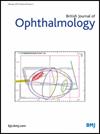Number of macula optical coherence tomography scans needed to detect glaucoma progression
IF 3.7
2区 医学
Q1 OPHTHALMOLOGY
引用次数: 0
Abstract
Background To evaluate the impact of testing frequency on the time required to detect statistically significant glaucoma progression for ganglion cell complex (GCC) with optical coherence tomography (OCT). Materials and methods From multicentre glaucoma registries, 332 eyes of 201 glaucoma patients were enrolled over an average of 4.4 years. Patients with 4 or more OCT tests were selected to calculate the longitudinal rates of GCC thickness change over time by linear regression. A computer simulation was then used to generate real-world GCC data and assess the time required to detect progression at different loss rates and testing frequencies based on variability estimates. Time and accuracy to detect worsening of progression were calculated. Results As testing frequency increased, the time required to detect a statistically significant negative GCC slope decreased, but not proportionally. All eyes with a GCC loss of −1 µm/year progressed after 3.8, 2.6 and 2.2 years on average when testing was conducted one, two and three times per year, respectively. For eyes with a GCC loss of −1.5 µm/year, progression was identified after 3.3, 2.2, and 1.8 years on average, respectively. Conclusion Increasing the frequency of macular OCT testing to three times per year more sensitively detects progression compared with two times per year. However, two times per year testing may be sufficient in clinical settings to detect progression and also to reduce the healthcare burden. Trial registration numbers [NCT00221897][1], [NCT00221923][2]. Data are available upon reasonable request. [1]: /lookup/external-ref?link_type=CLINTRIALGOV&access_num=NCT00221897&atom=%2Fbjophthalmol%2Fearly%2F2024%2F12%2F11%2Fbjo-2023-324916.atom [2]: /lookup/external-ref?link_type=CLINTRIALGOV&access_num=NCT00221923&atom=%2Fbjophthalmol%2Fearly%2F2024%2F12%2F11%2Fbjo-2023-324916.atom检测青光眼进展所需的黄斑光学相干断层扫描次数
研究背景:评估检测频率对光学相干断层扫描(OCT)检测神经节细胞复合体(GCC)青光眼进展所需时间的影响。材料和方法来自多中心青光眼注册中心,201名青光眼患者的332只眼被纳入研究,平均时间4.4年。选择4次或4次以上OCT试验的患者,通过线性回归计算GCC厚度随时间的纵向变化率。然后使用计算机模拟来生成真实的GCC数据,并评估在不同损失率和基于可变性估计的测试频率下检测进度所需的时间。计算了检测进展恶化的时间和精度。结果随着检测频率的增加,检测具有统计学意义的负GCC斜率所需的时间减少,但不成比例。当每年分别进行1次、2次和3次检测时,GCC损失为- 1 μ m/年的所有眼睛平均在3.8年、2.6年和2.2年后恢复。对于GCC损失为- 1.5µm/年的眼睛,平均分别在3.3、2.2和1.8年后发现进展。结论将黄斑OCT检查频率提高到每年3次比每年2次更敏感。然而,在临床环境中,每年两次的检测可能足以检测病情进展,并减轻医疗负担。试验注册号[NCT00221897][1], [NCT00221923][2]。如有合理要求,可提供资料。[1]: /查找/ external-ref ? link_type = CLINTRIALGOV&access_num = NCT00221897&atom = % 2 fbjophthalmol % 2恐惧% 2 f2024 % 2 f12 % 2季% 2 fbjo - 2023 - 324916。link_type=CLINTRIALGOV&access_num=NCT00221923&atom=%2Fbjophthalmol%2Fearly%2F2024%2F12%2F11%2Fbjo-2023-324916.atom
本文章由计算机程序翻译,如有差异,请以英文原文为准。
求助全文
约1分钟内获得全文
求助全文
来源期刊
CiteScore
10.30
自引率
2.40%
发文量
213
审稿时长
3-6 weeks
期刊介绍:
The British Journal of Ophthalmology (BJO) is an international peer-reviewed journal for ophthalmologists and visual science specialists. BJO publishes clinical investigations, clinical observations, and clinically relevant laboratory investigations related to ophthalmology. It also provides major reviews and also publishes manuscripts covering regional issues in a global context.

 求助内容:
求助内容: 应助结果提醒方式:
应助结果提醒方式:


